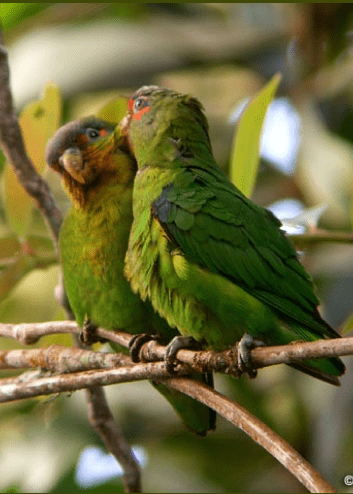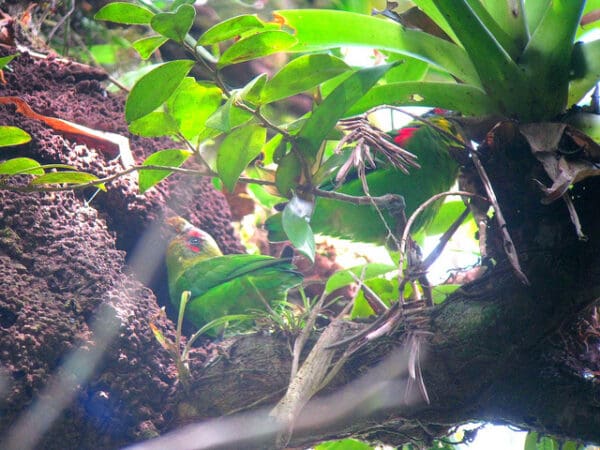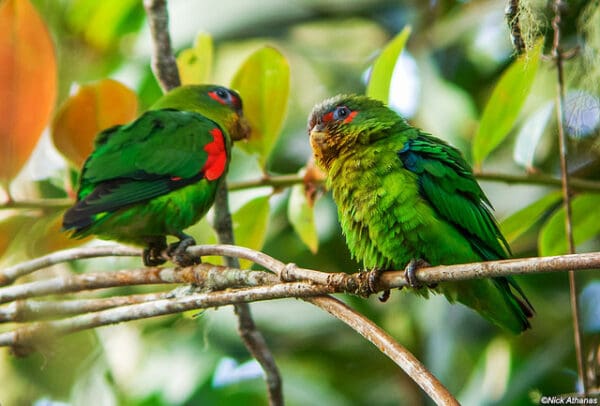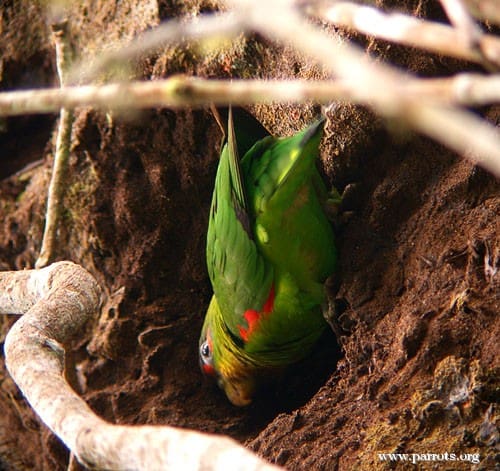Blue-fronted Parrotlet
Also known as:
Red-winged Parrotlet
Also known as:
Red-winged Parrotlet
DID YOU KNOW?
The Blue-fronted Parrotlet nests in termite mounds in trees, hollowing out the cavities themselves.

Touit

dilectissimus
Size:
17 cm (6.6 in)
Weight:
65 g (2.3 oz)
Subspecies including nominate:
one
Colour Adult:
Male– underparts green/yellow; red lores and line below eye; dull blue forecrown and band from lores across upper cheeks to ear coverts; red bend of wing, lesser, outer median and inner primary coverts; red forewing; yellow underwing coverts; black central tail feathers with green toward bases; green/yellow lateral tail feathers tipped with black. Beak olive/yellow with grey at base. Eye ring bare and grey/white. Eye brown/yellow. Female– red on lesser and outer median wing coverts minimal or absent.
Colour Juvenile:
As in adult female, but with green forecrown with scattered blue feathers; red and blue facial markings absent. Eye grey.
Call:
Calls in flight are soft and high-pitched notes repeated several times between pauses. Are louder when taking flight.
More Information:
Content Sources:
CITES
BirdLife International
Cornell Lab of Ornithology/Birds of the World
Parrots: A Guide to Parrots of the World, Juniper and Parr, 1998
Parrots of the World, Forshaw, 2006. 2010 edition
Lexicon of Parrots, Thomas Arndt.
Captive Status:
Not found in captivity.
Longevity:
—
Housing:
—
Diet:
—
Enrichment:
—
Nest Box Size:
—
Clutch Size:
Not recorded.
Fledging Age:
—
Hatch Weight:
—
Peak Weight:
—
Weaning Weight:
—
World Population:
Unknown, but described as uncommon. Declining.
IUCN Red List Status:
Least Concern
CITES Listing:
Appendix II
Threat Summary:
Not globally threatened. Uncommon to rare. Presumed to be declining locally from deforestation in N Colombia and a contracted range in Venezuela; however, habitat still remains and little trade exists.
Range:
Cerro Jefe area, C Panama, to W Colombia, south on western slopes of Andes to El Oro, SW Ecuador, and N Colombia, at northern extremity of Cordillera Oriental, Norte de Santander-Cesar border, east to Trujillo, NW Venezuela.
Habitat:
Found from 500-2000 m (1640-6560 ft) in humid and wet forest, including tall secondary growth forest and cloud forest, mainly in upland country.
Wild Diet:
Diet includes small seeds, fruits and blossoms. Recorded in Ecuador feeding on fruits of Clusia cf. alata.
Ecology and Behaviour:
Gregarious; birds roost communally in forest canopy. Some seasonal and altitudinal movements, presumably in response to food availability. Usually seen in pairs or small groups of up to 15 individuals. Easily overlooked while quietly feeding in canopy.
Clutch and Egg Size:
Not recorded.
Breeding Season:
Jun, Colombia; May–June, Panama. Nest is in arboreal termitarium.




![© Nick Athanas [CC BY-SA 2.0] via Flickr Wild Blue-fronted Parrotlets preen each other](https://gt2024.parrots.org/wp-content/uploads/2023/01/wpt_Blue-fronted-Parrotlet_1383-1-100x100.png)
![© ryanacandee [CC BY-SA 2.0] via Flickr A wild Blue-fronted Parrotlet pair works to enlarge a cavity in an arboreal termitarium](https://gt2024.parrots.org/wp-content/uploads/2023/01/wpt_Blue-fronted-Parrotlet_1383-3-100x100.jpg)
![© Nick Athanas [CC BY-SA 2.0] via Flickr Wild Blue-fronted Parrotlets perch on thin branches](https://gt2024.parrots.org/wp-content/uploads/2023/01/wpt_Blue-fronted-Parrotlet_1383-2-100x100.jpg)
![© Nick Athanas [CC BY-SA 2.0] via Flickr A wild Blue-fronted Parrotlet excavates soil](https://gt2024.parrots.org/wp-content/uploads/2023/01/wpt_Blue-fronted-Parrotlet_1383-100x100.jpg)